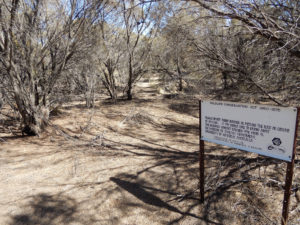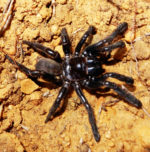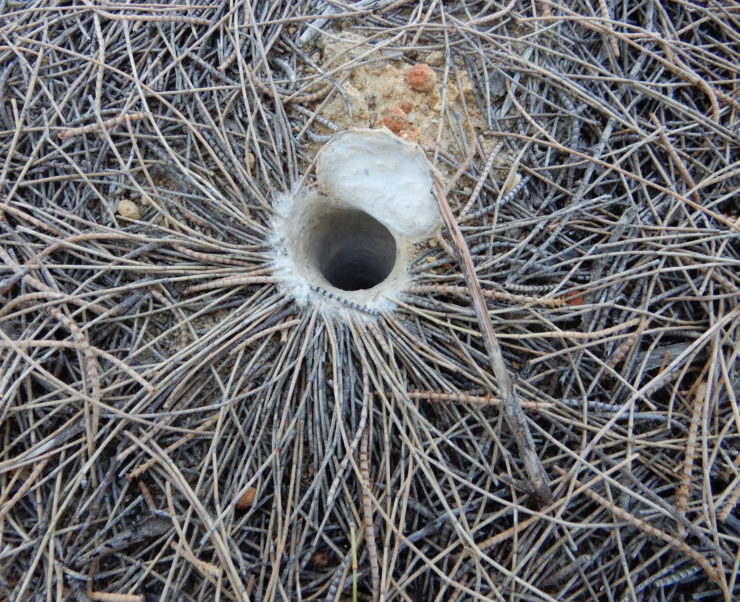EDITOR'S NOTE:Writing about science and animals (creatures?) can be challenging. It is essential to get it right. It is also essential to make it accessible. In other words, to translate the hard-to-know world to a semblance of the known without trivializing it. Several science-writer friends flagged this Washington Post story by Avi Selk, about the world's longest-living spider (that we know of) as the kind of piece that bridges those worlds. Contributor Rebecca Boyle was one of them, and interviews Selk. We present that interview in two posts. (And a nod of honor to original Spider 16 researcher Barbara York Main. She is the first woman scientist to be awarded a prestigious medal by the Royal Society of Western Australia.)
Today: The story behind the story of a spider. WARNING: Spider photo below.
Tomorrow: The process of writing fast (two pieces a day!) on deadline, via online research, phone and aggregation.
She was born in the summer of 1974, in the waning days of the Nixon Administration. Throughout her life, she weathered fire, drought, pestilence, downpours and a changing climate in her native land. She built her own home, where she gave birth to countless sons and daughters, not knowing their fate once they ventured out.
She died in the waning days of the Obama Administration. On Oct. 31, 2016, her longtime observers came to check on her, and found her dead, victim of a parasitic wasp.
She was 43 — an impressively ancient age for a spider.
The life and death of Spider 16, as she was known in the scientific literature, might have been relegated to just that – scientific literature. But as retold by Avi Selk of the Washington Post, Spider 16’s life story reached far deeper than her shallow, quarter-sized burrow.
Selk is a general assignment reporter, meaning he covers breaking news, from homicides to juicy celebrity incidents. But sometimes he plays with story structure and comes up with a real gem — like this one, about the fake planet Nibiru, target of conspiracy theorists. It's a choose-your-own-adventure marvel, and one of my favorite pieces of science writing published this year.
In the case of Spider 16, Selk says he realized right away that the demise of the world’s oldest spider, first reported by European news outlets, was something special. He turned his coverage into an elegy of sorts, narrating the spider’s life from the creature’s own perspective, leaning on interviews and scientific literature to channel her:
“After a year in her burrow, in 1975, she would have felt strange, heavy vibrations on the twigs outside her door. This often meant a predator was trampling around or a large forager like a kangaroo. This time, though, the vibrations were caused by Barbara York Main, who was standing directly over the burrow.”
The entire story is magical, down to the throat-catch you feel when you read the kicker. To find out how he pulled it off, I asked Selk about spiders, science storytelling, and how to get people to care about things they fear and don’t understand. Our conversation has been edited for length and clarity.
I noticed you cover a lot of tragedies and killings. There was this horrible thing about a kangaroo stoned to death. Some of your stories are neither funny or tragic, but just bizarre, like the mom who Tased her son to make him go to church. How do you come upon stories like this?
It's general assignment, so it's a mix of breaking news, and when there's no breaking news, just finding interesting stories — sometimes about spiders. In this specific case, it was actually my editor’s suggestion. My personal preference is away from the darker side, just because I used to be a cops reporter, so I've written tons of stories about death and mayhem. But the way the desk works, you take what you get. Sometimes there is stuff that I'm more interested in, and think readers will be interested in, too. And sometimes my editor finds one. These are stories other people have written that we look at potentially doing our own take on.
(On this day) I started messaging my editor around 6 a.m., before I left for the office. I was pitching things like, “Kanye West calls Emma Gonzalez his hero.” Raw Story: “Watch Texas school cop tell student to get out of my face and then shove him back into a wall.” We both thought those were kind of mediocre, so we had a back-and-forth with ideas for another half hour and my editor wrote ‘I’m intrigued by this,’ and posted the France24 version of the spider story. So I started writing it when I got into the office at 7.
Did you talk to (lead researcher) Barbara Main or get ahold of the other researchers?
The first thing I did was purchase the paper and contact the one author with an e-mail address, who was Leanda [Mason], and she got back to me right away, which a surprised because she's in Australia and it was nighttime there.

When I'm doing stories on scientific studies with people in different time zones, they're quite often just aggregated. I'll read the study and interpret what I can, and try to find some context, usually that other people have reported. But in this case, Leanda got back to me, and we talked for quite a long time. She gave me the story of this spider that went all the way back to Barbara Main, who was her mentor. Barbara is now in her late 80s and is not really healthy enough to talk to media, so I just talked to Leanda. I got a note from Barbara's daughter after the story published that said she appreciated it.
I'm wondering how you decided to approach this almost like an obituary. You kind of narrate the spider’s life in parallel with Barbara's career. And then there's this pretty line where you mentioned that (Barbara’s) health declined before the spider’s. Can you describe how you made that connection?
Any good animal story is really about people. Or at least readers are projecting some sort of human quality on the animal. In the phone conversation with Leanda, I was learning this whole story about how Barbara had been doing all these amazing things in this little preserved area of an otherwise decimated part of Australia, because she cared so much about spiders. Back in 1950, she must have been pretty rare, for a woman to be in science and biology. I thought that was quite lovely. And then the fact that the spider basically outlived her career, so that she had to pass the work on to the next generation. It had a really nice human parallel without having to make any trite, forced comparisons, like saying the spider was like a person. It’s like, no, the spider lived a long time and people came to care for it in that time because it lived so long.
It had a really nice human parallel without having to make any trite, forced comparisons...
Because I write everything very fast, I had originally thought I'd knock this story out in the morning, but it ended up taking the entire day. I thought I’d try to find the simplest structure, and put it all in the spider’s perspective. The spider is the story. It spanned both women, and whatever details I could find in the scientific paper, about things it would have seen — or not exactly seen, but crawled amongst. So I thought the framing was very straightforward. It’s chronological, beginning with the birth of the spider and then everything that I know the spider experienced, put down in order, including Barbara and Leanda and the wasps. To the spider, it’s all stuff that happened over the course of half a century.
Do you have any interest in spiders or animals in general?
I’m not a super animal person; I mean, I have a couple cats. I don't love spiders, but I sort of like them more than other bug life. They don't creep me out as much as they creep other people out. When I was a kid, I kind of adopted a garden spider, which was on our fence. I would feed it ants. So, it's not like I thought, ‘A spider!’ and hearts floated above my head, but I maybe didn't have the natural revulsion that a lot of people have. If this had been a story about a cockroach, I would have had that revulsion.
That, and just given the extraordinary amount of time that it lived, made me interested in how it lived. So when I was on the phone with Leanda, I basically asked her, ‘Rather than giving me the conventional science interview, as best you can, just tell me what a day in the life of the spider was like, beginning at its birth.’ And she did her best to do that with what she'd seen and studied. From the get-go, we just made it a personal story about the spider rather than a scientific article.
That's one thing that I found really appealing. I cover science, and mostly write about astronomy. But this is not a science story; it’s very much a personal story. I write so many stories that are like, ‘X expert says this about Y, and outside source says ‘maybe we need to look at it further,’ and The End.’ They're all kind of the same. This was really a unique structure. Did you fight with your editor about this at all? I can imagine another publication saying, ‘This is not an obituary, it's a spider. It's a journal article, do 300 words.’ “
I have been really lucky since I've been at the Post, which is just over a year. I’ll quite often write standard-form articles because I can't think of anything better. But whenever we decide to do something a little out of the box, the editors usually go for it.
‘Rather than giving me the conventional science interview, as best you can, just tell me what a day in the life of the spider was like, beginning at its birth.’
My default mode is that I’ll write two stories a day, so when the midday point had passed and I hadn't filed, I just got a question from my editor, and I said, ‘Ah I’m still working on it.’ I ended up filing it two hours after I should have gone home, and I told them, ‘Oh by the way it's like a 2,000-word story.’ My editor read it and said he liked it, but it read as long as it was, which wasn’t great. We ended up cutting about 300 words out of it the next morning and then publishing it first thing. So it was nothing to do with the form; he just said this is a really, really long story, let's try to make it a little shorter.
The anthropomorphism works well here, and that's actually something that I get annoyed with in other stories. I cover space, and often people are like, ‘It's so sad that this robot is gone,’ or a new Mars lander is going to go there, and it’s like, ‘Godspeed, little guy.’ But this worked. How did you draw that line, to not make it cheesy?
It's probably just random chance that it wasn't too cheesy. If you read far enough back in my archive, you'll probably find me overtly anthropomorphizing. I once wrote a story about a guppy in second person, as if the reader was the guppy. That was probably a little over the line. But I do it because it just helps. Anytime anyone reads anything, they want to read about something that they can relate to. So unless you anthropomorphize a little, there's just nothing for the reader to grasp onto.

In this case, I don't think I'm overtly trying to humanize the spider. I'm just sort of pointing out things, knowing that the reader might read between the lines and do the work for me. Like by pointing out it has a mother, and it is doing the same things its mother did, and by not calling it an ‘it’ but always calling it a ‘she.’ That was a little bit cheat-y, but at the same time, those are all just facts. It was really helped by the two main humans that appear in the story, who were both very eloquent about their own thoughts on what the spider means.
It seemed like Leanda Mason was a great interview.
She was. Couldn't ask for a better science interview. You know, sometimes scientists have a lot of trouble communicating.
But it’s always in there. If they are studying it, they're passionate about it.
Anytime anyone reads anything, they want to read about something that they can relate to.
It's just about exciting some emotions in them. It can be hard to draw that out during the interviews, but with Leanda it wasn't hard at all. Actually, Leanda was sort of drawing parallels between how the spider lived and how humans could live sustainably. So if anything, I had to remove some of her voice from the interview to just keep it more focused on the spider.
There are people in my household who fear and loathe spiders, and yet read this article and were intrigued by it. Were you aiming at arachnophobes, or do you think this would have worked if it was, like, a leopard?
I wasn't necessarily aiming. Not that I'm a philosopher on the subject, but I think whenever we have phobias of things it's because we don't understand them, and so if you can trick somebody into understanding a creature a little better, that loathing decreases. I wasn’t trying to trick anyone to read about the spider, but I did do some things. I made sure that the picture that would go out anytime someone tweeted it was not a picture of a spider, but a picture of this beautiful web tunnel that it had made.
The reaction on that story was overwhelmingly positive, and I've gotten more nice mail than I have ever gotten on any other story.



